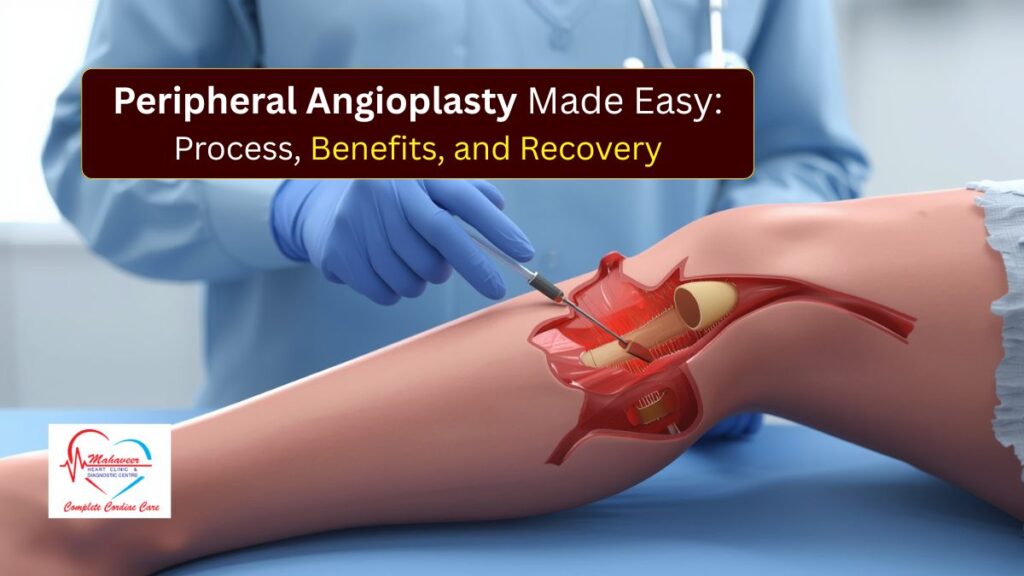
What Is Peripheral Angioplasty, How Does It Work, and What Are Its Benefits?
(Explained by Dr. Rakesh Jain, Cardiologist in Indore)
When arteries in your legs or arms become narrowed due to plaque buildup, it can reduce blood flow and cause serious discomfort or health risks. This condition is known as Peripheral Artery Disease (PAD). One of the most effective treatments for PAD is Peripheral Angioplasty—a minimally invasive procedure that helps restore proper blood circulation. Let’s understand what it is, how it works, and why it’s an important advancement in vascular care.
What Is Peripheral Angioplasty?
Peripheral Angioplasty is a medical procedure used to open blocked or narrowed arteries outside the heart, especially in the legs, arms, or pelvis. These arteries can become restricted due to fatty deposits, cholesterol, or plaque buildup, which limit oxygen-rich blood flow to the limbs.
During angioplasty, a cardiologist inserts a thin tube called a catheter into the affected artery through a small puncture, usually in the groin. The catheter has a small balloon at its tip that is gently inflated at the site of the blockage. This balloon presses the plaque against the artery walls, widening the passage and allowing smoother blood flow.
Sometimes, a stent (a tiny metal mesh tube) is placed inside the artery to keep it open and prevent future narrowing.
How Long Does Peripheral Angioplasty Take?
The duration of Peripheral Angioplasty can vary depending on the number of blockages and their location. On average, the procedure takes between 30 minutes to 2 hours. It is usually performed under local anesthesia, meaning you remain awake but feel no pain.
After the procedure, patients are monitored for a few hours, and most can return home the same or next day. Recovery time is relatively short, and patients can often resume light activities within a few days.
What Is the Success Rate of Peripheral Angioplasty?
Peripheral Angioplasty has a high success rate, especially when performed by experienced cardiologists. Studies suggest a success rate of 90–95% in restoring adequate blood flow and reducing symptoms like pain or cramping in the legs.
However, long-term results depend on several factors—such as the patient’s overall health, lifestyle, and whether they follow medical advice after the procedure. Adopting healthy habits like quitting smoking, controlling cholesterol, and regular exercise can significantly improve the long-term outcome.
What Is Peripheral Vascular Angioplasty?
Peripheral Vascular Angioplasty is another name for Peripheral Angioplasty. The term “vascular” refers to blood vessels in general. This procedure is part of vascular interventions, which are techniques used to treat diseases affecting arteries and veins throughout the body, excluding those in the heart and brain.
So, Peripheral Vascular Angioplasty focuses on improving blood flow in arteries outside the heart—mainly in the legs, arms, and sometimes kidneys. It’s a key treatment to relieve symptoms like leg pain while walking (claudication), non-healing wounds, or in severe cases, to prevent limb amputation.
When Is Peripheral Angioplasty Appropriate?
Peripheral Angioplasty is recommended when medications and lifestyle changes are not enough to relieve symptoms or when blood flow to a limb becomes critically low.
Common signs that indicate the need for angioplasty include:
Persistent pain or cramping in the legs during walking or rest
Numbness or weakness in the limbs
Non-healing sores or ulcers on feet or legs
Coldness or color change in the lower legs or feet
Your cardiologist may perform tests like Doppler ultrasound, CT angiography, or arteriography to confirm the severity of the blockage before recommending the procedure.
Benefits of Peripheral Angioplasty
Peripheral Angioplasty offers several benefits that make it one of the most preferred treatments for blocked arteries:
Improved Blood Flow: Restores proper circulation, reducing pain and discomfort.
Minimally Invasive: Requires only a small puncture, not open surgery.
Quick Recovery: Patients usually return to normal activities within a few days.
Reduced Risk of Amputation: Helps save limbs by improving oxygen supply.
Better Quality of Life: Enables pain-free walking and enhanced physical activity.
With these advantages, Peripheral Angioplasty plays a vital role in treating peripheral artery disease effectively and safely.
Role of Dr. Rakesh Jain – Cardiologist in Indore
Dr. Rakesh Jain, a highly experienced Cardiologist in Indore, specializes in performing Peripheral Angioplasty with precision and care. His expertise in interventional cardiology helps patients regain mobility, comfort, and confidence through advanced, minimally invasive treatments.
At his clinic, patients receive personalized care—from accurate diagnosis to post-procedure guidance. Dr. Jain emphasizes the importance of lifestyle changes and regular follow-ups to ensure long-term success after angioplasty. His patient-centric approach and use of modern technology make him one of the trusted cardiologists for Peripheral Angioplasty in Indore.
Final Thoughts
Peripheral Angioplasty has revolutionized the treatment of blocked arteries by offering a safe, quick, and highly effective alternative to surgery. Whether you’re suffering from leg pain, numbness, or circulation issues, consulting a specialist like Dr. Rakesh Jain can help you find the right diagnosis and treatment path.
Early detection and timely intervention can prevent complications and significantly improve your quality of life. If you experience any symptoms of poor blood circulation, don’t delay seeking expert advice.

